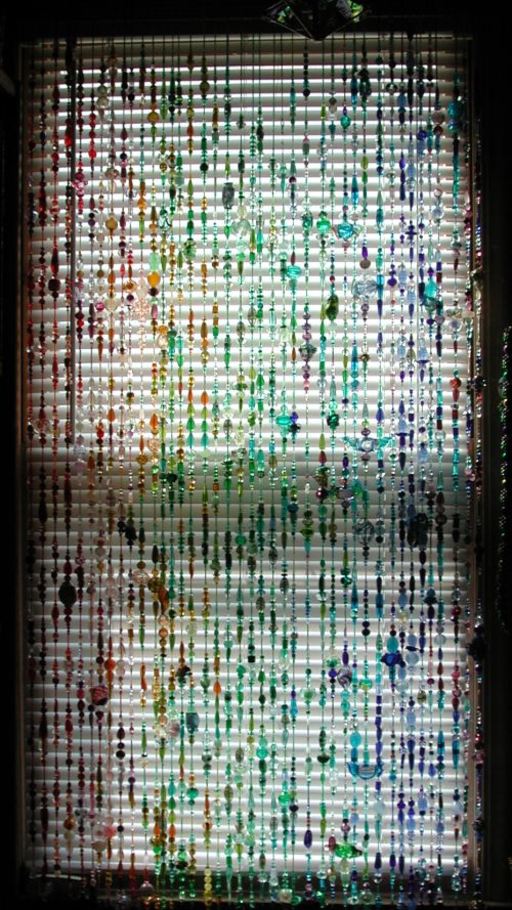After I'd been making my own glass beads for awhile, my standards (however difficult they might be to achieve in my own work) inevitably rose. —I became educated. The cracks, chill marks, bead release, mold seams, cold seals and other flaws that I had, if not taken for granted, at least not allowed myself to worry unduly over, were no longer acceptable, at least for the several hundred dollar necklaces.
Not having my friend's sensible attitude about selling beads I no longer want, but feeling unable to proceed to the good stuff while all the junk lingered, I faced a dilemma: what to do with all those Indian glass beads? Not to mention the many many many cracked beads I made myself? My failures tend to be comprehensive, and I was running out of space for the bad bead jars.
I decided a bead curtain would be just the thing to use up a lot of beads. Their imperfections wouldn't matter in the distance, and if a cracked one occasionally broke, the pattern would still be good enough. Bead curtains are often traditionally hung in doorways, but I don't have any suitable ones, and besides, given that many of the beads were extremely fragile, I wanted to hang them in an out of the way place. I selected a window, which has the added benefit of transmitting sunlight. Thus, I selected only transparent beads for this project, since most of the light is backlighting. As long as I didn't think a bead would immediately fall apart, it was fair game.
These beads are strung on 7 strand tigertail—another relic of my older days, before the advent of 49 strand beadalon. There are 41 strands, each about 60” long, plus 5–8” of seed beads at the top for hanging, a 1” diameter oak rod finished with tung oil and beeswax (because it was quick and lying around) In total the curtain weighs about 20 pounds. Most of the beads are soda lime, though there are a few borosilicate beads, badly blown, and some lead ones, including a great many satake purple that slightly melted together in the kiln. Though I probably spent only 80 hours or so stringing the beads in the freeform patterns my partner and I call “fantasy”, I've been working off and on this project for over a year (I had to periodically collect more bad beads.) I get email about the bead curtain, so I've added a FAQ page
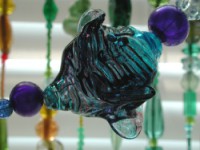
This modern bead is made by either sticking together randomly or casing a transparent over a transparent to make a hollow bead.
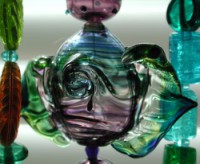
I love the colors in this bead, and was only a little disappointed when I discovered a tiny crack in one of the center twists, because it meant I could keep the bead for the curtain.
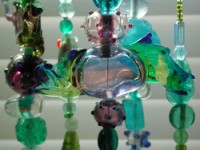
The beads above are a variation on this design, an oval bead flattened into a disk with flaps or wings added. I have a terrible time keeping these from cracking, especially using soda lime glass. Too used to those little 15mm rounds that I can air cool, and pop into a 900 degree kiln without difficulty, I guess. But these biggies (this bead is probably about 3” or 75mm across) don't crack, then they hole-pop.
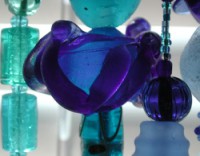
An earlier effort to develop a focal with multiple points of attachment for the stringer. I think having beads with extra loops, third holes and the like makes for fabulous design possiblities but somehow my customers don't have the same enthusiam. They're underwhelmed, in fact.
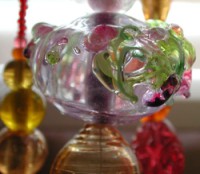
This is a much earlier bead, a dichro core with floral decorations. Beautiful bead, but core beads—cylinders with a hollow bead built around them, also tend to crack very readily, as the mandrel sucks heat out of the core while the outer jacket stays hot. They commonly crack right at the juncture of core and outer bead. Add trailing to the mix, and again, if they don't crack, they pop.
Click on the thumbnails for a larger image, 500 pixels wide.
added tag, summary 19nov17. Added photo caption, 21nov17.
Unless otherwise noted, text, image and objects depicted therein copyright 1996--present sylvus tarn.
Sylvus Tarn